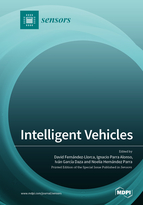Intelligent Vehicles
A special issue of Sensors (ISSN 1424-8220). This special issue belongs to the section "Intelligent Sensors".
Deadline for manuscript submissions: closed (31 May 2020) | Viewed by 158559
Special Issue Editors
Interests: automated and autonomous vehicles; predictive perception and planning; human-vehicle interaction; trustworthy artificial intelligence; traffic behaviour; assistive intelligent transportation systems; digital twins for ITS
Special Issues, Collections and Topics in MDPI journals
Interests: Vehicle localization; autonomous vehicles; driver assistance systems; imaging and image analysis
Special Issues, Collections and Topics in MDPI journals
Interests: accurate mapping systems based on optimal optimization algorithms; advanced driver assistance systems; assistive intelligent vehicles; driver and road user state and intent recognition; dynamic and cinematic car models; intelligent localization systems based on LiDAR odometry; intelligent navigation and localization systems based on inertial navigation systems; intelligent-vehicle-related image, radar, and LiDAR signal processing; sensor fusion systems for driverless cars
Special Issues, Collections and Topics in MDPI journals
Interests: accurate indoor and outdoor global positioning; vehicle localization; autonomous vehicles; driver assistance systems; imaging and image analysis
Special Issues, Collections and Topics in MDPI journals
Special Issue Information
Dear Colleagues,
When we talk about intelligent vehicles or driverless cars, we can (almost) state that the future is now. Both industry and academy have made tremendous advancements in the last decade in this field, and a considerable number of prototypes are now autonomously driving our roads. Technology and research findings are moving quickly, and the race is on to develop intelligent vehicles that enable everyone to enjoy safe, efficient, and sustainable mobility.
The capability of intelligent vehicles to sense, interpret, and fully understand the current traffic scene, as well as to infer future states and potential hazards, maybe the main challenge in the driverless cars’ arena. Current scene understanding technologies and methodologies depend on multiple sensor systems, such as cameras (visible or infrared spectrum), radar, LiDAR, and so on, and are based on highly complex and sophisticated algorithms, including artificial intelligence. New approaches to model the behavior of other road users (VRUs and drivers) are needed in order to ensure the safety of the control strategies. Robust sensing under different lighting and weather conditions becomes mandatory to advance towards fail-aware, fail-safe, and fail operational systems.
The aim of this Special Issue is to contribute to the state-of-the-art, and to introduce current developments concerning the perception and sensor technologies for intelligent vehicles. We encourage potential authors to submit contributions of original research, new developments, and substantial experimental works concerning intelligent vehicles. Surveys are very welcomed too.
Therefore, prospective authors are invited to submit original contributions or survey papers for review for publication in the Sensors open access journal. Topics of interest include (but are not limited to) the following:
- Sensor technologies for driverless cars
- Vehicle scene understanding
- Vulnerable road users (VRUs) protection
- Vehicle navigation and localization systems
- Advanced driver assistance systems
- Intelligent vehicles related image, radar, and LiDAR signal processing
- Sensor and information fusion
- Human factors and human machine interaction
- Assistive intelligent vehicles
- Driver and road users state and intent recognition
- Cooperative driving
- Sensing under different lighting and weather conditions
- Fail-safe, fail-aware, and fail-operational systems
- HD and accurate mapping systems
Prof. Dr. David Fernández-Llorca
Prof. Dr. Ignacio Parra Alonso
Prof. Dr. Iván García Daza
Prof. Dr. Noelia Hernández Parra
Guest Editors
Manuscript Submission Information
Manuscripts should be submitted online at www.mdpi.com by registering and logging in to this website. Once you are registered, click here to go to the submission form. Manuscripts can be submitted until the deadline. All submissions that pass pre-check are peer-reviewed. Accepted papers will be published continuously in the journal (as soon as accepted) and will be listed together on the special issue website. Research articles, review articles as well as short communications are invited. For planned papers, a title and short abstract (about 100 words) can be sent to the Editorial Office for announcement on this website.
Submitted manuscripts should not have been published previously, nor be under consideration for publication elsewhere (except conference proceedings papers). All manuscripts are thoroughly refereed through a single-blind peer-review process. A guide for authors and other relevant information for submission of manuscripts is available on the Instructions for Authors page. Sensors is an international peer-reviewed open access semimonthly journal published by MDPI.
Please visit the Instructions for Authors page before submitting a manuscript. The Article Processing Charge (APC) for publication in this open access journal is 2600 CHF (Swiss Francs). Submitted papers should be well formatted and use good English. Authors may use MDPI's English editing service prior to publication or during author revisions.
Keywords
- Intelligent vehicles
- Sensors
- Road users behavior modeling
- Sensor and information fusion
- Advanced driver assistance systems
- Image, radar, and LiDAR signal processing
- Human factors
- Fail-safe, fail-aware, and fail-operational










